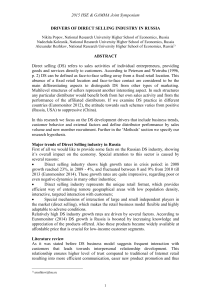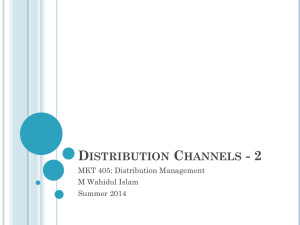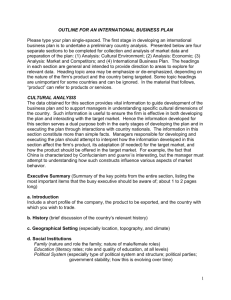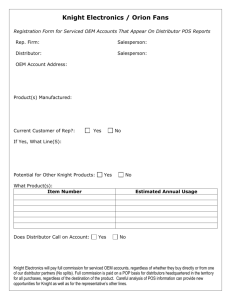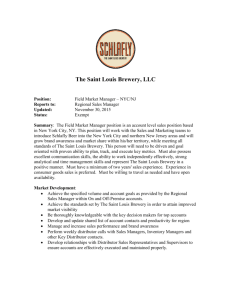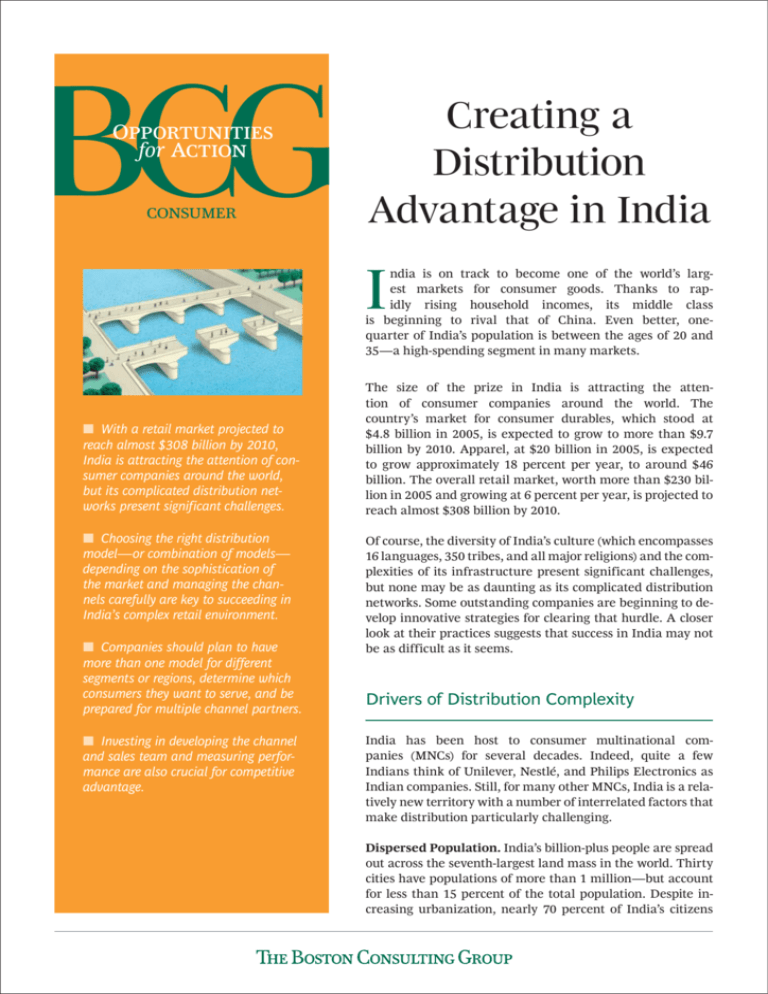
O
for A
CONSUMER
Creating a
Distribution
Advantage in India
I
ndia is on track to become one of the world’s largest markets for consumer goods. Thanks to rapidly rising household incomes, its middle class
is beginning to rival that of China. Even better, onequarter of India’s population is between the ages of 20 and
35—a high-spending segment in many markets.
■ With a retail market projected to
reach almost $308 billion by 2010,
India is attracting the attention of consumer companies around the world,
but its complicated distribution networks present significant challenges.
■ Choosing the right distribution
model—or combination of models—
depending on the sophistication of
the market and managing the channels carefully are key to succeeding in
India’s complex retail environment.
■ Companies should plan to have
more than one model for different
segments or regions, determine which
consumers they want to serve, and be
prepared for multiple channel partners.
■ Investing in developing the channel
and sales team and measuring performance are also crucial for competitive
advantage.
The size of the prize in India is attracting the attention of consumer companies around the world. The
country’s market for consumer durables, which stood at
$4.8 billion in 2005, is expected to grow to more than $9.7
billion by 2010. Apparel, at $20 billion in 2005, is expected
to grow approximately 18 percent per year, to around $46
billion. The overall retail market, worth more than $230 billion in 2005 and growing at 6 percent per year, is projected to
reach almost $308 billion by 2010.
Of course, the diversity of India’s culture (which encompasses
16 languages, 350 tribes, and all major religions) and the complexities of its infrastructure present significant challenges,
but none may be as daunting as its complicated distribution
networks. Some outstanding companies are beginning to develop innovative strategies for clearing that hurdle. A closer
look at their practices suggests that success in India may not
be as difficult as it seems.
Drivers of Distribution Complexity
India has been host to consumer multinational companies (MNCs) for several decades. Indeed, quite a few
Indians think of Unilever, Nestlé, and Philips Electronics as
Indian companies. Still, for many other MNCs, India is a relatively new territory with a number of interrelated factors that
make distribution particularly challenging.
Dispersed Population. India’s billion-plus people are spread
out across the seventh-largest land mass in the world. Thirty
cities have populations of more than 1 million—but account
for less than 15 percent of the total population. Despite increasing urbanization, nearly 70 percent of India’s citizens
Creating a Distribution Advantage in India
still live in rural areas. These people constitute 30 to 50
percent of the market for basic consumer goods.
Retailing Density. With more than 12 million retail
outlets, India has one of the highest retailing densities
in the world. Mom-and-pop stores account for more
than 95 percent of the total market across most product categories. An organized retail sector has begun to
emerge, but it represents only 3 to 4 percent of the overall market.
Channel Intermediaries. Most distribution models in
India involve many intermediaries between companies
and their retailer customers and have varying costs
and benefits. The wholesaler model, for instance—in
which large, powerful wholesalers buy products from
manufacturers and sell them to the retailers that they
finance—gives producers little control over the distribution channel but provides considerable reach. By
contrast, under the distributor model, the distributor
acts as an extension of the manufacturer and operates
exclusively within a specified territory. Other distribution channels involve dealers, who operate as both
wholesalers and retailers and are served directly by the
manufacturer. Still others involve various stockists and
substockists. All these intermediaries can add complexity when they wear two hats at once, as they often do.
A distributor selling to retailers in one territory, for example, might have a retail presence of its own in the
same or a different territory.
Infrastructure Complexity. Only a few full-service
distribution companies operate in India, and intermediaries must transact business along a relatively poor
transportation system. Consider the journey a shipment
of soap might make from the manufacturer in Baddi (an
excise-tax-free zone in northern India) to a retailer in
rural Tamil Nadu (a state in southern India). First, the
shipment is stored by the carrying and forwarding agent
at a warehouse near Baddi for a few days. Then it spends
15 days being trucked by a contracted transporter to the
Tamil Nadu distributor. Along the way, it crosses eight
state borders and multiple checkpoints. It is then transported to the district headquarters by a smaller truck
or even a three-wheeler. The village retailer buys a few
packs from the local wholesaler, and the remainder of
the shipment makes its final journey to the village on a
state transport bus—or, quite possibly, a bullock cart.
Manufacturers are forced to devise ingenious logistical
strategies to manage these bottlenecks.
Unorganized Markets. In several sectors of the consumer industry, business is largely unorganized and
2
consists of small local companies. These producers
thrive where product complexity and manufacturing
investment are low and taxes are high. They often deal
in cash and use recycled or substandard components.
They offer retailers very high margins but have little
control over pricing discipline or channel practices.
The presence of these small producers creates a competitive environment characterized by low prices and
strong channel partners—a significant challenge for organized players.
The strategies that companies are developing to deal
with these factors have become sources of competitive
advantage. Choosing the right distribution model—or
combination of models—and managing the channels
carefully are therefore key to succeeding in India’s complex retail environment.
Finding the Right Mix
Distribution models in India vary by the number of layers in the channel, the intermediaries used, and the
number of channel partners. Every model requires
manufacturers to make a tradeoff between their degree
of control and their reach. The goal is to find a balanced
mix of approaches that confers a unique advantage depending on the sophistication of the market. (See the
exhibit “The Right Distribution Model Depends on the
Sophistication of the Market.”) The following are some
guidelines for finding the right distribution model for
your business.
Plan to have more than one distribution model for
different segments or regions. Obviously, the distriThe Right Distribution Model Depends
on the Sophistication of the Market
Wholesaler
model
Distributor
model
Directto-retailer
model
Organizedretailer
model
Market sophistication
Cement
Packaged
goods
Home appliances
Low
Paints
Air
conditioners Apparel
High
Manufacturer control
Manufacturer reach
High
Source: BCG analysis.
Low
Creating a Distribution Advantage in India
bution model a company chooses must be aligned with
its business model and with consumers’ needs. But one
model is rarely sufficient for all segments of a market.
Most companies choose a mix to reach their dispersed
customer base. Consider the following examples:
• The Indian subsidiary of a major consumer-goods company works with more than 1,000 distributors, which
deliver its products to more than 1 million outlets across
India. It uses the distributor model to sell to outlets in
urban areas, a small corporate team to sell to organized
retail chains, and partnerships with local groups in rural areas to reach the mostly ignored market of less affluent consumers.
• A home-improvement-products company developed
a hybrid structure that mixes the wholesaler and
distributor models, along with the organized-retailer
model—in which there is no intermediary between
manufacturer and large retailer. It also sells some products directly to consumers, to whom it offers services
as well.
• A global consumer-electronics company mixes the
distributor and organized-retailer models in a slightly
different way. It uses a distributor to serve small outlets
but manages large ones directly through a small group
at the center. It has also begun to open its own franchised retail shops to carry its brand exclusively.
Carefully determine which consumers you want to
serve. Not every company operating in India needs a
nationwide distribution network across all cities and
towns. Although India’s population is dispersed, there
are sharp differences in income between regions. A
leading consumer-durables company, for example, has
two different distribution networks for two different categories of products. For the category in which demand
is dispersed throughout the country, the company uses
a nationwide distribution network. For the other category—in which the top 15 cities account for nearly 70
percent of sales—it uses a distribution plan that targets
the major dealers.
Be prepared for multiple channel partners. Given
the fragmented nature of India’s distribution channels,
companies often have to work with several hundred
channel partners. Some companies use thousands of
distributors and stockists to reach more than a million
retail outlets. One advantage of using many distributors is that a company retains some power over and
independence from them. But it must ensure that
each distributor is large enough to provide benefits for
3
all the others in the channel. The right number and
layering of channel partners will depend on the business, its target segments, and the types of partners
available.
Invest in developing the channel and sales team.
Overseeing large numbers of people can be difficult,
but investment in channel partners is crucial for competitive advantage. Successful companies pay as much
attention to retaining a distributor with the right resources, capabilities, and attitude as they do to hiring
a senior employee. Companies that provide channel
partners with training, selling support, and coaching
programs differentiate their offering from that of their
competitors and earn high returns.
Sales-force effectiveness is especially important. Managing a network of distributors is different from managing relationships with organized retailers. A home
electronics company, for example, uses a geographically
dispersed sales team to manage the wholesale channel
(which comprises midsize players) and a centralized
sales force to manage some key accounts. The level of
experience and capabilities of each team is aligned to
match its customers’ requirements.
Always measure performance. The complexity of
India’s distribution channels and the inexperience of
some channel partners can complicate performance
measurements. Nevertheless, such measures are important to maintain. One leading packaged-goods company
records its products’ availability at the retail counters of
nearly 1 million outlets every week, and it links each
distributor’s payments to the results. Measures of channel partners’ performance should include their economic health, payment terms, and inventory costs. And it is
important for companies to regularly track their reach
across cities and their share of sales across retailers to
measure the strength of the channel.
These guidelines are crucial to establishing a strong distribution structure. When choosing the right distribution models for their business, companies should also
consider the following questions:
• Which consumer segments should we target in order to
meet our business objectives?
• What regions and town classes do we need to cover in
order to reach these consumers?
• What mix of distribution models would give us an advantage over our competitors?
Creating a Distribution Advantage in India
• What investments in skill development are required for
the channel and sales force?
• What metrics do we need to put in place for measuring
and reviewing performance?
India will remain a multifaceted economic, social, and
trade puzzle for at least the next 20 years, and traditional and modern trade will necessarily continue to live
side by side. Manufacturers must learn to manage all
formats and channels as seamlessly as possible when
serving the country’s vast and varied markets.
Vikram Bhalla
Arindam Bhattacharya
Abheek Singhi
Sharad Verma
Vikram Bhalla is a partner and managing director in the Mumbai
office of The Boston Consulting Group. Arindam Bhattacharya
is a partner and managing director in the firm’s New Delhi office. Abheek Singhi is a principal in BCG’s Mumbai office. Sharad
Verma is a principal in the firm’s New Delhi office.
You may contact the authors by e-mail at:
bhalla.vikram@bcg.com
bhattacharya.arindam@bcg.com
singhi.abheek@bcg.com
verma.sharad@bcg.com
To receive future publications in electronic form about this topic
or others, please visit our subscription Web site at www.bcg.com/
subscribe.
© The Boston Consulting Group, Inc. 2007.
All rights reserved. 5/07
4

